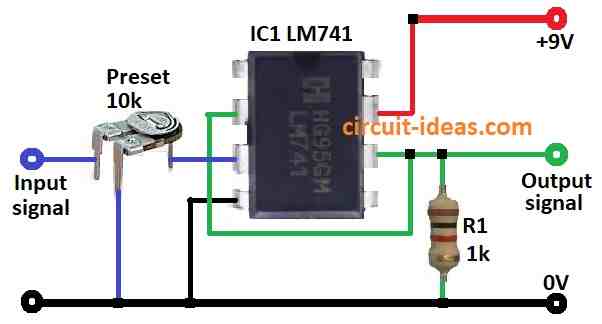Simple Voltage Follower Circuit using Op-amp IC 741 give output same like input.
It is also called buffer amplifier or unity gain amplifier.
IC 741 op-amp is cheap and useful that is why so many people use it.
Voltage follower has high input impedance and with low output impedance.
It can give current to many loads and output there is no change.
It take very little current from input like sensor.
Circuit Working:

Parts List:
| Category | Description | Quantity |
|---|---|---|
| Resistor | 1k 1/4 watt | 1 |
| Preset 10k | 1 | |
| Semiconductors | IC 741 | 1 |
IC 741 Op-Amp which is a Tiny Power Chip:
- IC 741 is small 8 pin op-amp chip used in many circuits.
- Here we talk about one circuit using this IC.
Inputs and Outputs of IC 741:
- IC 741 has two input pins and pin 3 is non-inverting (+) and pin 2 is inverting (–).
- Pin 6 is output pin.
- It works with max 22V from battery or dual power.
Not Just Voltage Follower an IC 741 Does More:
- IC 741 is general op-amp not only for voltage follower.
- It can work as comparator and compare voltages
- Multivibrator make wave signals
- Integrator add voltage
- Differentiator find voltage change speed
- And active filter passes only some frequencies
Voltage Follower Circuit an easy and useful:
- Input signal goes to pin 3 (+)
- Pin 2 (–) connect back to output pin 6 and this is called feedback.
- Power come from battery to special pins.
- Output goes to resistor like R1 which is the load.
Why Use Voltage Follower?
- Big input impedance go up to 1 million ohm with small output impedance.
- This means the circuit take very small current from sensor/input but can give current to many loads.
- Signal does not loses strength.
Formulas:
Voltage Gain Formula for Voltage Follower Op-Amp like LM741.
Formula:
Av = Vo / Vin = 1
where:
- Av is the voltage gain
- Vo is the output voltage
- Vin is the input voltage
Note:
Voltage gain is 1 Output voltage same as input voltage.
Why? Because op-amp has very high gain.
It makes voltage at pin 2 (–) almost same as pin 3 (+).
Pin 2 is connected to output pin 6 through resistor R1.
So output follow input.
Ohms Law Relation Between Current, Voltage and Resistance:
Formula:
I = V / R
where:
- I is the current in amps like water flow in pipe
- V is the voltage in volts like water pressure
- R is the resistance in ohms Ω like narrow pipe slowing flow
Summary:
More voltage means more current
More resistance means less current
Ohms law works best in ideal condition
Real circuits may change due to heat or other effects.
How to Build:
To build a Simple Voltage Follower Circuit using Op-amp IC 741 follow the below mentioned steps:
- Collect all parts as shown in diagram.
- Connect pin 2 to pin 6 of IC 741.
- Connect pin 3 to input signal using 10k preset.
- Connect pin 4 to ground.
- Connect pin 6 to output signal using resistor R1.
- Connect pin 7 to +9V supply.
- Connect R1 to ground between pin 6 and output.
Safety Notes:
- Be safe while working with circuits.
- Use correct voltage and good components.
- Follow general safety rules always.
Conclusion:
Simple Voltage Follower Circuit using Op-amp IC 741 is easy and useful.
It gives same output as input with no signal loss.
High input impedance with no load on input.
Low output impedance can drive many loads.
It is good for many circuit uses.
Leave a Reply